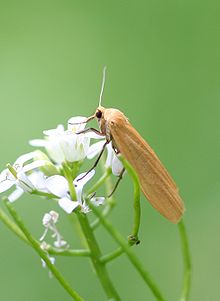| Orange footman | |
|---|---|

| |

| |
| Scientific classification | |
| Domain: | Eukaryota |
| Kingdom: | Animalia |
| Phylum: | Arthropoda |
| Class: | Insecta |
| Order: | Lepidoptera |
| Superfamily: | Noctuoidea |
| Family: | Erebidae |
| Subfamily: | Arctiinae |
| Genus: | Wittia |
| Species: | W. sororcula |
| Binomial name | |
| Wittia sororcula (Hufnagel, 1766) | |
| Synonyms | |
| |
Wittia sororcula, the orange footman, is a species of moth in the family Erebidae. The species was first described by Johann Siegfried Hufnagel in 1766. It is found in Europe, Anatolia and further east across the Palearctic to southern Siberia and the Amur basin to China.
Technical description and variation
For a key to the terms used, see Glossary of entomology terms.The wingspan is 27–30 millimetres (1.1–1.2 in). Forewing with the costa strongly convex and therefore the apical portion of the forewing considerably broader than in the forms of the luterella group. Head, thorax, end of abdomen and the forewing bright golden yellow, the hindwing of male but little paler; in the female both wings slightly paler orange yellow. In contradistinction to lutarella, the costal area of the hindwing above and beneath is never black.
Transfer from Eilema to Wittia
The orange footman was previously placed in the genus Eilema, but was transferred to the genus Wittia by Vladimir Viktorovitch Dubatolov in 2011.
Subspecies
- Wittia sororcula sororcula
- Wittia sororcula orientis (Daniel, 1954)
Biology
The moth flies from April to June depending on the location. Larva blackish, with two yellow dorsal stripes with red dots and white spots. The larvae feed on lichen on trees, both on conifers (Ochsenhemer) and on deciduous trees (Spuler). It can be obtained by beating saplings, bushes and grass. It is sometimes found feeding at flowers in the daytime.
Gallery
References
- ^ Dubatolov, V. V. & Zolotuhin, V. V. (2011). "Does Eilema Hübner, [1819] (Lepidoptera, Arctiidae, Lithosiinae) present one or several genera?" (PDF). Euroasian Entomological Journal. 10 (3): 367–379, 380, VII.
- Seitz, A. Ed. Die Großschmetterlinge der Erde, Verlag Alfred Kernen, Stuttgart Band 2: Abt. 1, Die Großschmetterlinge des palaearktischen Faunengebietes, Die palaearktischen Spinner und Schwärmer, 1912- 1913.
 This article incorporates text from this source, which is in the public domain.
This article incorporates text from this source, which is in the public domain.
External links
- Kimber, Ian. "72.049 BF2043 Orange Footman Eilema sororcula (Hufnagel, 1766)". UKMoths. Retrieved July 11, 2019.
- Savela, Markku (ed.). "Eilema Hübner, [1819]". Lepidoptera and Some Other Life Forms. Retrieved March 18, 2018.
- Eilema sororcula at Fauna Europaea
- "10499 Eilema sororcula (Hufnagel, 1766) - Dottergelbes Flechtenbärchen". Lepiforum e. V.
| Taxon identifiers | |
|---|---|
| Eilema sororcula |
|
This Lithosiina-related article is a stub. You can help Misplaced Pages by expanding it. |


